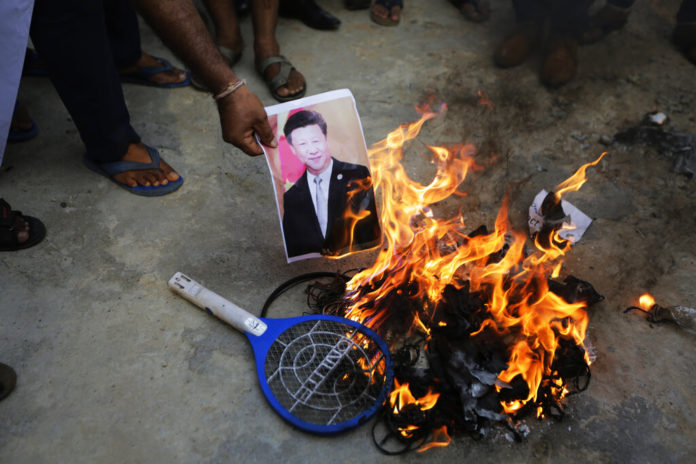
SRINAGAR, India (AP) — A confrontation between Indian and Chinese troops along the nations’ disputed Himalayan border left at least 20 Indian soldiers dead in a region where thousands of soldiers on both sides have been facing off for over a month, the Indian army said Tuesday.
Join our WhatsApp groupSubscribe to our Daily Roundup Email
The clash — during which neither side fired any shots, according to Indian officials — is the first deadly confrontation between the two Asian giants since 1975.
While the Indian Army initially reported just 3 casualties, it later raised the death toll to 20 Indian soldiers. The army’s originally report said that three Indian soldiers had died, but later said 17 additional soldiers succumbed to injuries they suffered in the sub-zero temperatures of the high-altitude terrain.
China, for its part, accused Indian forces along the border of carrying out “provocative attacks” on its troops, leading to “serious physical conflicts” between the sides.
According to a report by ANI news, the Chinese suffered 43 casualties in the face-off, including some dead and seriously injured.
Indian intercepts reveal that Chinese side suffered 43 casualties including dead and seriously injured in face-off in the Galwan valley: Sources confirm to ANI pic.twitter.com/xgUVYSpTzs
— ANI (@ANI) June 16, 2020
Foreign Ministry spokesman Zhao Lijian gave no details of any casualties on the Chinese side, but said that China had strongly protested the incident while still being committed to maintaining “peace and tranquility” along the disputed and heavily militarized border.
“But what is shocking is that on June 15, the Indian troops seriously violated the consensus of the two sides, crossed the border illegally twice and carried out provocative attacks on Chinese personnel, resulting in serious physical conflicts between the two border forces,” Zhao said.
India’s Ministry of External Affairs said in a statement that the incident happened “as a result of an attempt by the Chinese side to unilaterally change the status quo” in the Galwan Valley.
Thousands of soldiers from the two countries, backed by armored trucks and artillery, have been facing off just a few hundred meters (yards) apart for more than a month in the Ladakh region near Tibet. Army officers and diplomats have held a series of meetings to try to end the impasse, with no breakthrough.
Indian authorities have officially maintained near-total silence on the issues related to the confrontation, and it was not immediately clear how the three Indian soldiers died.
But two Indian security officials familiar with latest developments told The Associated Press that soldiers from the two sides engaged in fistfights and stone-throwing, which led to the casualties. Both said that no shots were fired by either side. The officials spoke on condition of anonymity in keeping with government regulations.
Indian Prime Minister Narendra Modi did not comment on the clash in a televised meeting Tuesday with state officials.
The tense standoff started in early May, when Indian officials said that Chinese soldiers crossed the boundary in Ladakh at three different points, erecting tents and guard posts and ignoring verbal warnings to leave. That triggered shouting matches, stone-throwing and fistfights, much of it replayed on television news channels and social media.
China has sought to downplay the confrontation while saying the two sides were communicating through both their front-line military units and their respective embassies to resolve issues.
The disputed border covers nearly 3,500 kilometers (2,175 miles) of frontier that the two countries call the Line of Actual Control.
Though skirmishes aren’t new along the frontier, the standoff at Ladakh’s Galwan Valley, where India is building a strategic road connecting the region to an airstrip close to China, has escalated in recent weeks.
India and China fought a border war in 1962 that also spilled into Ladakh. The two countries have been trying to settle their border dispute since the early 1990s without success.
Since then, soldiers from the two sides have frequently faced off along the frontier, which stretches from Ladakh in the north to the Indian state of Sikkim in the northeast.
Lt. Gen. D.S. Hooda, a former head of the Indian military’s Northern Command, under which Kashmir and Ladakh fall, said the incident was the “most serious confrontation” between India and China since 1975, when Chinese troops killed four Indian soldiers in an ambush in the Twang region of northeastern India’s Arunachal Pradesh state.
“It’s a very complicated and serious situation, and it will take real, hard negotiating skills to resolve this,” Hooda said.
Lt. Gen. Vinod Bhatia, a former director-general of Indian military operations, said the incident was “serious but local.”
“Such incidents can happen, particularly when (opposing) soldiers are in such proximity,” he said.
The Indian army statement said the “violent faceoff” occurred “during the de-escalation process underway in the Galwan Valley.”
Indian officials say Chinese soldiers commit more than 500 border transgressions annually. China claims about 90,000 square kilometers (35,000 square miles) of territory in India’s northeast, while India says China occupies 38,000 square kilometers (15,000 square miles) of its territory in the Aksai Chin Plateau in the Himalayas, a contiguous part of the Ladakh region.
India unilaterally declared Ladakh a federal territory while separating it from disputed Kashmir in August 2019. China was among the handful of countries to strongly condemn the move, raising it at international forums including the U.N. Security Council.
